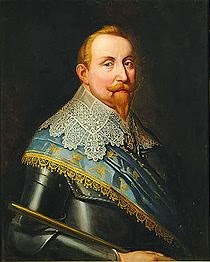
History: Gustavus Adolphus, the The Lion of the North
Søren Ralph Christensen has a large Pike & Shotte 30 Years War collection, and after painting up his Gustavus Adolphus model decided to write up a short history.
I wanted to complete my 30 Years War collection with some proper Commander in Chief figures, and when talking 30 Years War, who better to model than Gustavus Adolphus, the The Lion of the North, or ”Das Löwe aus dem Mitternacht” as they probably would have said in the German countryside at the time.
The king’s portrait
Gustavus innovated and revolutionized the military field tactics of his time, fascinating people including later great commanders like Napoleon. Using cavalry as shock troops, and adding flexible firepower in the ranks, using small detachments of musketeers along with his innovative use of field artillery, he laid the foundation for victories like Breitenfeld and Lützen.
Gustavus’ success as a military innovator also saw him plough his way into the 30 Years War, laying the foundation for a Swedish Empire that would stand almost 100 years. But he would do it at a very high price.
“God with Us” – Gustavus preparing for the charge
Always leading from the front, a bullet wound from the previous Polish campaign prevented Gustavus from wearing a breastplate. This would prove to have fatal consequences at Lüzten, were he rode to his death in a mad cavalry charge, leading the Swedish Smålands Cavalry into an isolated situation on the battlefield. Here he caught a bullet in the arm that severed the bone.
Streiff – now on display at the Royal Armory Museum in Stockholm
His horse, Streiff, also got hit, and became increasingly hard to control. In the confusion Gustavus got surrounded by enemy cavalry, received another gunshot to the lower body and fell to the ground. A mad fight followed between the few men Gustavus had left and the Imperial cavalry unit. All the Swedes were slain but one, who survived his wounds to later tell the story of what ensued.
The death of Gustavus at Lützen 1632
The King laying wounded on the ground, was encircled by the dismounted enemy cavalry. Upon asking him the question “Who are you sir?” he answered truthfully “I’m Gustavus, the King of Sweden”. Realizing the value of their prisoner, the enemy troopers tried to bring the wounded king with them. Unfortunately Gustavus had at this time in his life become pretty obese. The job proved too hard on the Imperials, and before leaving him behind, they shot him in the head, ran their swords through the now dead king a few more times, robbed him of his clothes and jewellery and took off.
 Streiff taking his master into the midst of battle.
Streiff taking his master into the midst of battle.
The wounded horse, Streiff, had meanwhile returned to the Swedish lines with an empty saddle. This had immediate demoralizing effect, as it became clear to all that something terrible had happened to the King. Frantic rallying and stern discipline saw the Swedes through the rest of the battle, and the Imperials left the field to them in the early evening. But it was a costly victory indeed.
The horse and all the kings’ clothes was later returned from Austria to Sweden, as a gift of friendship. They can now be seen at the Royal Swedish Armory Museum in Stockholm.
You can find more of Søren’s work on his blog, and we plan to feature more here too!













